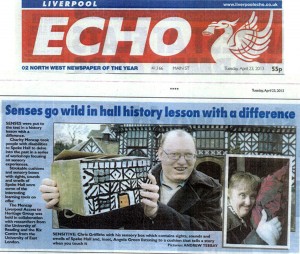Interactive sensory objects made for and by people with learning disabilities, www.sensoryobjects.com is a three year AHRC funded research project which explores the potential of newly developed easy-to-use electronics in making the experience of members of the user-group more vital and meaningful when accessing heritage sites.
The Digitally Ready grant gave us the opportunity to experiment and share our research from the Sensory Objects research project with students from the art dept, giving them an introduction to interactive and digitally enhanced sculpture/installation. Technology plays a major role in many contemporary installations, but art students may not have easy access to the kinds of technologies that can add a sensory dimension to their work and learning curves can be steep.
Through a series of hands-on workshops we introduced students to simple electronics, for example we used ‘squishy circuits’ conductive and insulating dough to introduce the students to circuits, http://courseweb.stthomas.edu/apthomas/SquishyCircuits/ to activate LED lights, trigger sounds or movement.
The students were encouraged to experiment with various interactive materials such as conductive fabrics and threads, embedded circuits and shape memory wire which can be made to change shape by applying a current (possibly controlled using Arduino or similar).
We explored different ways of obtaining input from the environment and introduced students to a variety of basic sensors, which respond with some form of movement, light or sound.
Art students from the second year to PhD were given the option to sign up workshop places.
Follow up tutorials and online help was available as the group started to build the technology into their own projects. Two students completed work for their final assessment exhibitions and others continue to develop ideas for future work. We gave the students the equipment and asked them to return the kit if they decided not to use it.
The workshops and links to equipment are documented here
http://introductiontointeractivesculpture.blogspot.co.uk/
In response to our workshops we were invited to apply for further funding from a ‘one off’ T&L fund which was successful so we will continue to develop the Sensors, Circuits and Sculpture workshops next year. We aim to start earlier so that we can offer more workshops to the students over three terms and cover more ground, particularly by going into greater depth and having time to explore student suggestions and ideas further. We have also invited members of art dept staff to attend the workshops.
Draft Plans for Sensors Circuits and Sculpture 2013-14
Autumn Term 2013
In the Autumn term we will focus on interactive spaces and explore how sensors can be used to interact with an architectural space and the data used to provide actions via a microcontroller. We will look at a variety of sensors (light, touch, proximity, force, etc.), how they differ and how to work with the input that they provide. Students will be introduced to electrical principles using ‘Squishy Circuits’ and conductive ink which will provide a platform to explore some basic principles. This will be followed with an introduction to the Arduino microcontroller via practical examples, constructing some simple sensors from basic materials such as foam and resistive plastic, and learn how to write programs to control them. Remaining workshop will build upon the knowledge of using Arduino, and explore how to embed the microcontroller into artworks.
Spring Term 2014
In the Spring Term the focus will shift to wearable electronics, where students will experiment with conductive fabrics and threads, and construct circuits embedded into clothing and controlled by a Lilypad microcontroller that is designed specifically for this purpose. We will explore methods of providing input through sensors (e.g. tilt, squeeze, stretch) that are stitched into clothes, and how these actions can be turned into useful output such as generating sound or light displays.
Summer 2014
The last term will look at more advanced aspects of using microcontrollers in artworks, and focus on the generation of sounds either through add on cards (such as MP3 players or Waveshields) or via a synthesiser on a laptop. Students will be introduced to sound generation by constructing of a simple touch synthesizer made from foam and foil. To this, they will add and explore the use of other sensors to control sound and how the physical aspects of music creation can be captured through construction of their own sensing devices.








